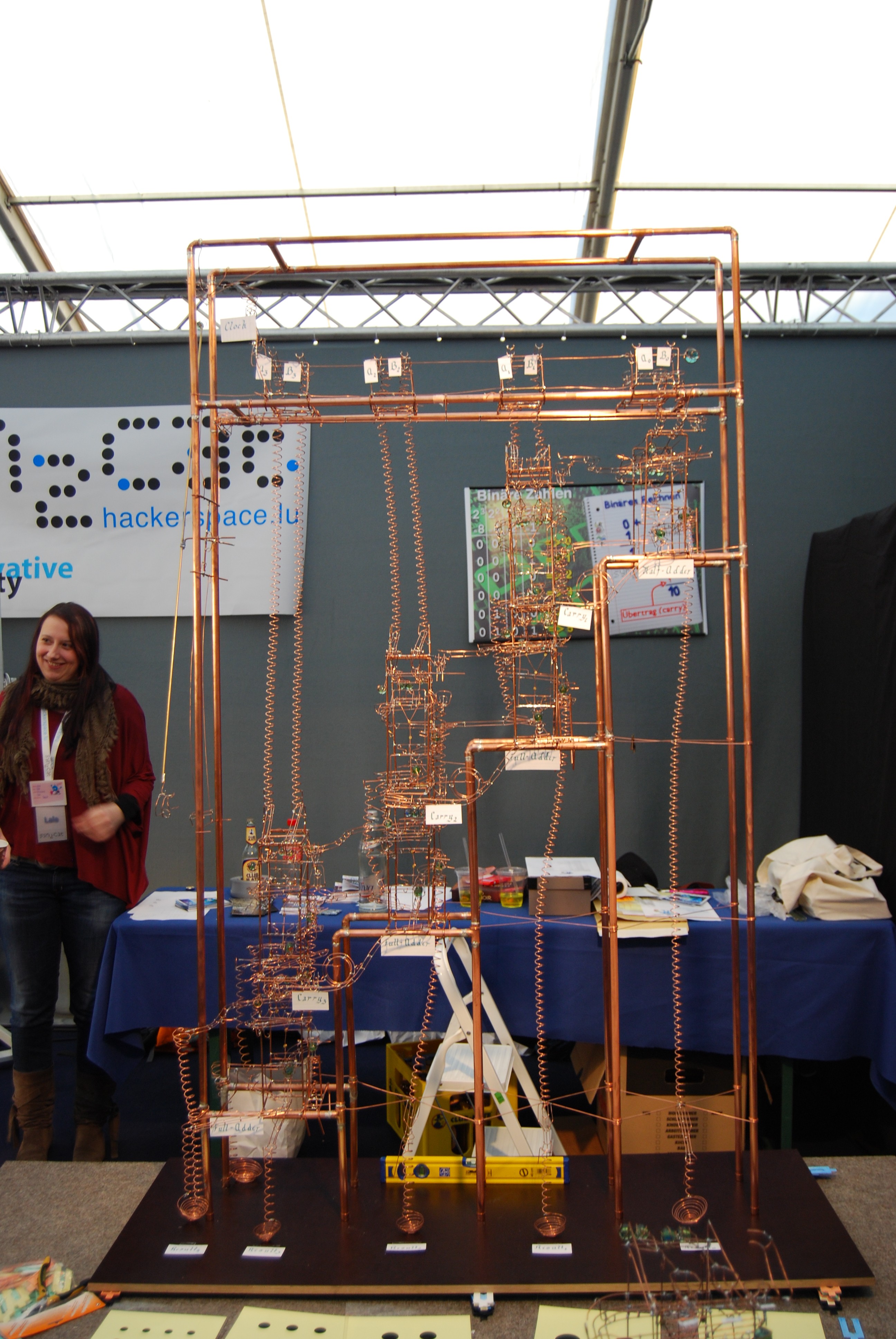Being a bit late with our submission we came up with the nice idea to explain binary logic. Research on the Internet showed several ideas but none was really going into depth of the true logic inside computers. The initial aim to do Lego models was changed into doing a copper construction which should be more stable. The Lego models would be used as course support material.
We applied an iterative creation process and building modular components. This allowed us to create a fully functional 4 bit binary adder using real logic models. We also put emphasis on the general steam-punk style of the machine. The whole construction is only composed of copper, solder and glass marbles. No other material was used except for the wooden base.
Half adders were build which can then be connected together to form more complex logic. Each half adder has several fixed places where marbles can pass from one to the next. That is some sort of API between the different half adder modules.
Being a first-time participant in the science festival, we were somewhat worried whether we could run the show, since most of our educationally trained staff was busy with the “Foire de l’Etudiant”. The science festival group was composed of engineers in computer science and students of various levels which don’t necessarily have the skills to teach children. Maybe the hardest part was thus not building and assembling all those logic gates, but devising a clever and appealing way to explain binary logic to pupils and their teachers. In the end, the no-fuss approach of simply jumping into the cold water finally resulted in some really great presentations.
After the fist couple of classes the show was rolling smoothly, just the voice got worse and worse with the high noise level. Our booth was probably one of the few which had quite a heavy load of theory. Despite this potential turn-off, the pupils were all very interested. Also we varied the presentation spontaneously to feature less theory and more marble run depending on the audience.
The initially planned 11 classes were spontaneously extended to 14 as during the pause times, some teachers with their complete class showed up to ask if we could give them a talk. It seems the word spread that there was something cool to learn and see. Unfortunately very few higher level classes showed up.
During the weekend, the general public was really amazed just by the look of the copper construction. This probably also triggered our appearance on national TV as well as in newspapers. The most asked question was how long it took to build. We didn’t really know so the answer was a wild guess of “4 people during 3 months”.
The presentation done during the first 2 days was of no great use for the weekend and we settled into several people doing short individual talks. There was almost constantly a crowd in front of our booth but not too many people were asking questions unless we went forward and invited on-watchers to get some explanations who always took up this offer.
In general we had 2 kinds of visitors. There were the technically interested (teachers in computer science, parents with a technical background) who were amazed at how we were able to show the precise logic inside a microchip. There were the artistically inspired people and of course the children, who saw a highly complex marble run with fancy levers doing multiple actions simultaneously. Some photographers spent a long time on our booth and we invited them backstage to get some nicer close-up shots of the copper construction.
Sometimes we were surprised by the various people. There was the 5 year old who could tell his mum “look I can do 1+1 with marbles and it says 2” as well as the grandmother who knew binary from her teaching days and was staring, eyes wide open, at the machine. And of course, it is still a marble run. Everybody loves marble runs!
Most people did not immediately realize we were an a.s.b.l. and thought this was coming from a high school or university. That was quite flattering. Of course we profited from the occasion to hand out flyers of our club. Also several parents were interested in our monthly “hackids” effort, tutoring young people from 10 to 18 years old. We were able to make connections with several like-minded people and other institutions present at the festival which is quite a valuable asset that we got from our presence. The success of our attendance shows up in our getting invited to present our adder at science discovery days or weeks at several secondary schools.
We’re already plotting about what to do in 2 years time, maybe reusing the existing machine in some way or another. Meanwhile we need to come up with a storage solution for the device. It’s quite huge and taking up a massive amount of space in our already crammed club rooms.
More infos: http://wiki.hackerspace.lu/wiki/ScienceFestival2011






















Re where to put it, I would suggest the MNHN as a recipient. Or perhaps Casino. In the meantime, I bet if a protective plexiglass box were made, the entry hallway could be used as permanent storage.
Gunstick and collaborators are still looking at making some improvements like an automated lift, and so on.. following that, we may see to its (more) permanent storage.
when it will happen?
Sorry, when will what exactly happen?